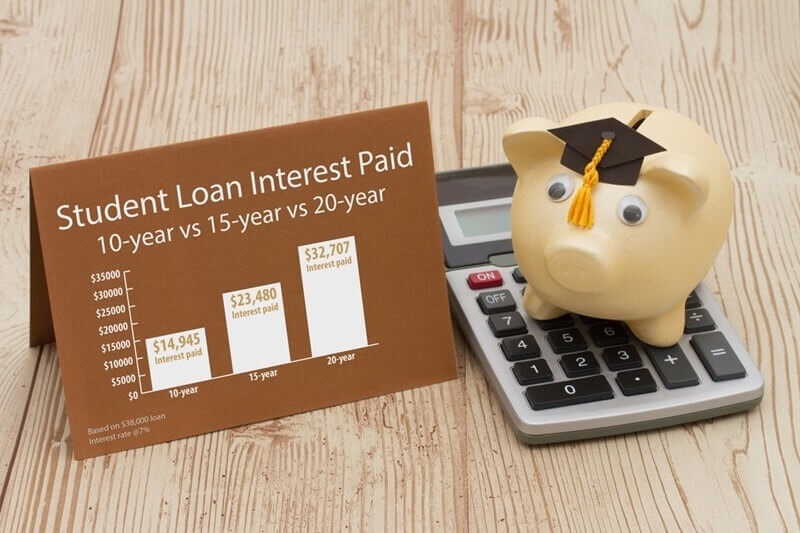
For most Americans, student loans are not only a monetary expense but a long-term commitment that governs life decisions—from profession to homeownership. With shifting policies, fresh repayment strategies, and frequent interest rate adjustments, it is a good idea to stay current. Understanding how interest operates on student loans, what the latest federal alterations involve, and whether refinancing is recommended or not are all aspects of debt duty.
This guide offers student loan interest explained in simple terms, examines federal student loan changes, emphasizes refinancing student loans, addresses interest rate updates for borrowers, summarizes sound repayment options, and provides sound student debt planning tips.
Essentially, interest is the cost of borrowing money. For college loans, the loans are structured such that interest will be paid after the funds are disbursed. Interest computation and compounding have significant lasting effects on borrowers, and therefore, the explanation of student loan interest is a good place to begin.
For example, if you're delayed in payment through deferment or forbearance, the accrued interest during this time can capitalize upon payment resumption. Informed about student loan interest, you are able to manage and anticipate these costs and minimize them where possible.

Federal student loan policy can fluctuate from term to term, and the last few years have witnessed a significant overhaul. The Department of Education makes periodic adjustments to interest rates, repayment terms, and forgiveness provisions, and these federal student loan changes directly affect millions of borrowers.
Income-driven repayment plans are one of the places where some of the most dramatic changes happen. Recalculations of income limits and discretionary income adjustments have been focused on reducing the price of payments. Expansions within the Public Service Loan Forgiveness program have also made it easier for public servants to become forgiveness. These advances illustrate the value of keeping up with federal student loan news—borrowers who do can alter repayment plans in order to save money or qualify for relief.
Another important area is temporary relief. During economic downturns or crises, lawmakers have occasionally waived payments or excused interest altogether. Such provisions for relief illustrate the ways by which federal student loan changes can specifically lower the cost of accruing interest, even on a temporary basis.
While federal changes may alter repayment terms, student loan refinancing is a backup for borrowers as well. Refinancing is a means of borrowing a new loan from a private lender in exchange for the replacement of one or more student loans. The objective is usually to gain a lower interest rate, lessened terms of repayment, or to combine payments.
For borrowers with good credit histories and stable incomes, student loan refinancing offers significant savings in the long run. Lowering your rate by just one percentage point translates to thousands of dollars in saved interest, especially for larger balances. Refinancing also allows borrowers to switch from variable to fixed rates, or vice versa, depending on personal preference and risk tolerance.
But there are some trade-offs that come with refinancing. After you refinance federal loans through a private lender, you are no longer eligible for income-driven repayment plans, federal forgiveness programs, or protection measures such as deferment or forbearance. That is why it is necessary to learn about student loan interest explained before refinancing. Borrowers have to weigh the long-term benefit of lower rates against the potential loss of federal protections.
One of the most eagerly awaited aspects of student loans is the adjustment of yearly federal loan interest rates. The government makes public the rates that will be paid back during the upcoming school year every spring. Borrower interest rate notices are tied to the financial markets and rise or fall with respect to the general state of the economy.
Private lenders, too, alter their products based on the market conditions, and therefore one can compare refinance terms provided intermittently by borrowers. Borrower rate of interest changes can offer a chance to get a lower rate if one waits for the right time. An interest rate environment that is rising could be a signal to get a fixed rate as early as possible.
Borrowers need to watch for interest rate news. This is not just for students borrowing anew; even existing borrowers benefit from understanding the impact the rate environment has on refinancing terms or future repayment expenses. Being proactive keeps you from ever being caught off guard by changing conditions.
More than the interest mechanics or federal policy compliance is required in order to manage student loans successfully. The most successful borrowers employ careful repayment strategies.
While repayment plans focus on the "how," overall general student loan plan guidelines address the "why" and the "when." A thoughtful plan makes sure that your student loans fit into your overall financial goals rather than dominate them.
Sensible student loan management involves more than just sending in a check each month. Investing the time to educate yourself on student loan interest clarified, keeping up with federal student loan news, tracking interest rate notices to borrowers, student loan refinancing where it is beneficial, and employing savvy repayment strategies will enable borrowers to regain control of their financial future. Bringing responsible student debt planning strategies into play means repayment is no longer reactive but proactive and in sync with the grand scheme of life objectives.
In an economic climate where rates and regulations continue to change, information is power. The more you understand, the more intelligently you can make choices, and the sooner you can arrive at a future where your student loans no longer dictate your fate.
This content was created by AI